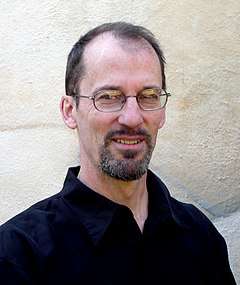David P. Anderson
| David P. Anderson | |
|---|---|
 | |
| Born |
1955 (age 61–62) Oakland, California, USA |
| Residence | Berkeley, California, USA |
| Fields | Computer science |
| Institutions | University of California, Berkeley |
| Alma mater |
Wesleyan University University of Wisconsin, Madison |
| Thesis | A Grammar Based Methodology for Protocol Specification and Implementation (1985) |
| Doctoral advisor | Lawrence Landweber |
| Doctoral students | Shin-Yuan Tzou, Ramesh Govindan |
| Known for | Volunteer computing |
| Notable awards |
NSF Presidential Young Investigator Award IBM Faculty Development Grant |
David Pope Anderson (born 1955) is an American research scientist at the Space Sciences Laboratory, at the University of California, Berkeley, and an Adjunct Professor of Computer Science at the University of Houston. Anderson leads the SETI@home, BOINC, Bossa and Bolt software projects.
Education
Anderson received a BA in Mathematics from Wesleyan University, and MS and PhD degrees in Mathematics and Computer Science from the University of Wisconsin–Madison. While in graduate school he published four research papers in computer graphics.[1] His PhD research involved using enhanced attribute grammars to specify and implement communication protocols.[2]
Career
From 1985 to 1992 he was an Assistant Professor in the UC Berkeley Computer Science Department, where he received the NSF Presidential Young Investigator and IBM Faculty Development awards. During this period he conducted several research projects:
- FORMULA, a parallel programming language and runtime system for computer music.[3]
- DASH, a distributed operating system with support for digital audio and video.[4]
- Continuous Media File System (CMFS), a file system for digital audio and video [5]
- Comet, an I/O server for digital audio and video.[6]
From 1992 to 1994 he worked at Sonic Solutions, where he developed Sonic System, the first distributed system for professional digital audio editing.[7]
Inventions
In 1994 he invented "Virtual Reality Television", a television system allowing viewers to control their virtual position and orientation. He was awarded a patent for this invention in 1996.[8]
In 1994 he developed one of the first systems for collaborative filtering, and developed a web site, rare.com, that provided movie recommendations based on the user's movie ratings.
From 1995 to 1998 he was Chief Technical Officer of Tunes.com, where he developed web-based systems for music discovery based on collaborative filtering, acoustics, and other models.
In 1995 he joined David Gedye and Dan Werthimer in creating SETI@home, an early volunteer computing project. Anderson continues to direct SETI@home.
From 2000 to 2002, he served as CTO of United Devices, a company that developed software for distributed computing.
Berkeley Open Infrastructure for Network Computing
In 2002 he created the Berkeley Open Infrastructure for Network Computing project, which develops an open-source software platform for volunteer computing.[9] The project is funded by NSF and is based at the UC Berkeley Space Sciences Laboratory. BOINC is used by about 100 projects, including SETI@home, Einstein@home, Rosetta@home, Climateprediction.net, and the IBM World Community Grid. It is used as a platform for several distributed applications in areas as diverse as mathematics, medicine, molecular biology, climatology, and astrophysics.[10]
Anderson was involved in Stardust@home, which used 23,000 volunteers to identify interstellar dust particles via the Web - an approach called distributed thinking. In 2007 Anderson launched two new software projects: Bossa (middleware for distributed thinking), and Bolt (a framework for web-based training and education in the context of volunteer computing and distributed thinking).
Berkeley Open System for Skill Aggregation
The Berkeley Open System for Skill Aggregation (BOSSA) is a software framework for distributed thinking,[11] using volunteers on the Internet to perform tasks that require human intelligence, knowledge, or cognitive skills.
References
- ↑ Hidden Line Elimination in Projected Grid Surfaces
- ↑ A Grammar Based Methodology for Protocol Specification and Implementation
- ↑ Formula: a programming language for expressive computer music
- ↑ The DASH Project: an Overview
- ↑ A File System for Continuous Media
- ↑ A Continuous Media I/O Server and its Synchronization Mechanism
- ↑ A Distributed Computer System for Professional Audio
- ↑ U.S. Patent 5,714,997: Virtual Reality Television System
- ↑ BOINC - A System for Public-Resource Computing and Storage
- ↑ BOINC - Berkeley Open Infrastructure for Network Computing on YouTube, Dr. David Anderson describes SETI@home, BOINC and Volunteer Computing
- ↑ http://boinc.berkeley.edu/workshop_07.ppt p.39 (September 6, 2007)
External links
| Wikinews has related news: Exclusive: David Anderson talks about the Stardust@home project |